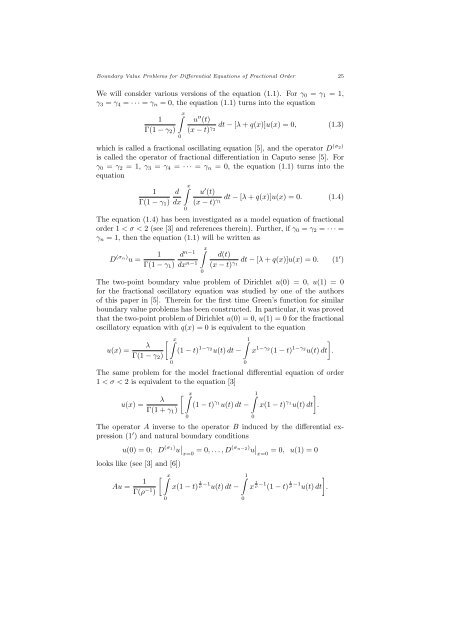FOR DIFFERENTIAL EQUATIONS OF FRACTIONAL ORDER
FOR DIFFERENTIAL EQUATIONS OF FRACTIONAL ORDER
FOR DIFFERENTIAL EQUATIONS OF FRACTIONAL ORDER
You also want an ePaper? Increase the reach of your titles
YUMPU automatically turns print PDFs into web optimized ePapers that Google loves.
Boundary Value Problems for Differential Equations of Fractional Order 25We will consider various versions of the equation (1.1). For γ 0 = γ 1 = 1,γ 3 = γ 4 = · · · = γ n = 0, the equation (1.1) turns into the equation∫1xΓ(1 − γ 2 )0u ′′ (t)(x − t) γ dt − [λ + q(x)]u(x) = 0, (1.3)2which is called a fractional oscillating equation [5], and the operator D (σ 2)is called the operator of fractional differentiation in Caputo sense [5]. Forγ 0 = γ 2 = 1, γ 3 = γ 4 = · · · = γ n = 0, the equation (1.1) turns into theequation1Γ(1 − γ 1 )∫dxdx0u ′ (t)(x − t) γ dt − [λ + q(x)]u(x) = 0. (1.4)1The equation (1.4) has been investigated as a model equation of fractionalorder 1 < σ < 2 (see [3] and references therein). Further, if γ 0 = γ 2 = · · · =γ n = 1, then the equation (1.1) will be written asD (σ n) u =1Γ(1 − γ 1 )d n−1dx n−1∫x0d(t)(x − t) γ 1 dt − [λ + q(x)]u(x) = 0. (1′ )The two-point boundary value problem of Dirichlet u(0) = 0, u(1) = 0for the fractional oscillatory equation was studied by one of the authorsof this paper in [5]. Therein for the first time Green’s function for similarboundary value problems has been constructed. In particular, it was provedthat the two-point problem of Dirichlet u(0) = 0, u(1) = 0 for the fractionaloscillatory equation with q(x) = 0 is equivalent to the equationu(x) =[ ∫xλ(1 − t) 1−γ 2u(t) dt −Γ(1 − γ 2 )0∫ 10]x 1−γ 2(1 − t) 1−γ 2u(t) dt .The same problem for the model fractional differential equation of order1 < σ < 2 is equivalent to the equation [3]u(x) =[ ∫xλ(1 − t) γ 1u(t) dt −Γ(1 + γ 1 )0∫ 10]x(1 − t) γ 1u(t) dt .The operator A inverse to the operator B induced by the differential expression(1 ′ ) and natural boundary conditionsu(0) = 0; D (σ 1) u ∣ ∣x=0= 0, . . . , D (σ n−2) u ∣ ∣x=0= 0, u(1) = 0looks like (see [3] and [6])[ ∫x1Au =Γ(ρ −1 x(1 − t) 1 ρ −1 u(t) dt −)0∫ 10]x 1 ρ −1 (1 − t) 1 ρ −1 u(t) dt .
















